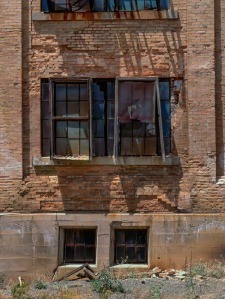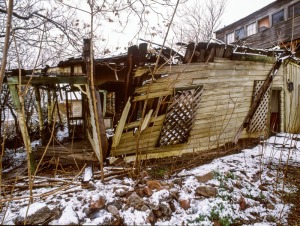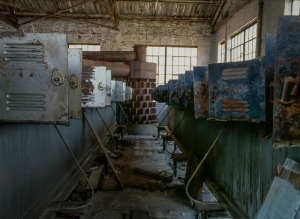Jerome, Arizona’s ruins are slowly disappearing. In March 2017, the roof of the Cuban Queen fell down, an iconic building that the Jerome Historical Society planned to restore.
The grand hulks that became symbols of the ghost town that it became known for—hospital, elementary school, Daisy Hotel and Douglas Mansion—have been restored and have become, respectively, the Grand Hotel, Town Hall, a private residence and State Historic Park.
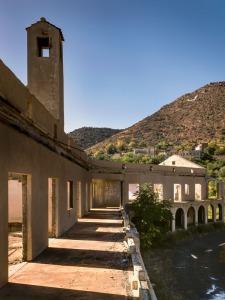
Leigh and Richard were married in the Little Daisy; kids loved to skateboard theses floors; and the fire department benefits here were great. Photo by Bob Swanson (Swansonimages.com)
The floor of the Bartlett Hotel, the only ruin that remains on Main Street, is filled with coins pitched by tourists at an old outhouse and toilet and rusted mining artifacts. This odd coin toss earns as much as $6500 a year for the Jerome Historical Society. Behind the shop now called Pucifer, the remains of the brick ‘cribs’, home of Jerome’s ladies of the night, were taken down by a previous owner to gain access to the back of the building. The bricks were neatly stacked. Then the bricks slowly disappeared. As Jane Moore commented, it was a ‘crime.’
The Jerome that I moved to in 1979 was still forlorn and decrepit looking, needing rescue. Today, Jerome has become modernized. Spiffed up. Gentrified.
Money flows in from tourist veins that are as rich as any gold mine. Over a million visitors a year come to shop, party in the bars, gawk at the views, and hear tales of bordellos, gunslingers, and ghosts. The shops are full of art, jewelry, and handmade clothing, award-winning wines and exotic olive oils.
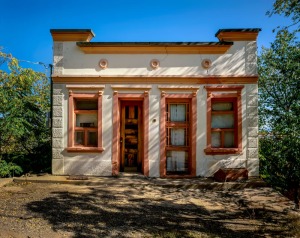
The Jerome Historical Society wanted to restore the old Cuban Queen, symbol of the mining city bordellos. Then the roof caed in. For those of us who lived in Jerome in the Jade/Rosie days, it was their home and magnet/tile making studio. I still have some of them. (Photo by Bob Swanson)
The names of many businesses play on the mythology of ghosts: The Haunted Hamburger, Ghost Town Inn, the Spirit Room bar, Ghost Town Tours, and Ghost Town Gear. The Grand Hotel provides ghosts meters to visitors interested in documenting their contacts. The annual Jerome Ghost Walk is one of the most popular events that the Jerome Historical Society produces. It draws many hundreds of people to its re-enactments of historic events.
Many don’t mourn the loss of ruins. Sometimes tourists fell off the old walls. Shopkeepers complained ruins were fire hazards and dubbed them liabilities. Many homes that once went for under a $1000 have sold for over a quarter of a million dollars. In the ghost town years, they were ripe for pickings and vandalism. Up to the 1980’s, residents would find people wandering through their yards, saying, “I thought this was a ghost town.”
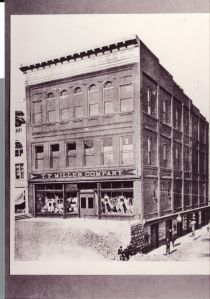
The iconic T.F. Miller building was ordered to be torn down by Phelps Dodge in 1953. “Jerome is finished,” a mine official said. Kids were paid a penny a piece to clean the bricks. (Photo courtesy: Jerome Historical Society)
I never tired of walking among Jerome’s ruins. The shards of Jerome’s fabulous mining past were embedded in its abandoned buildings, crumbling walls, and collapsed roofs. Ruins shared visible histories of this once powerful and fabled city—“the richest copper mining city” in the West. There were ghosts in those ruins; you could feel them.
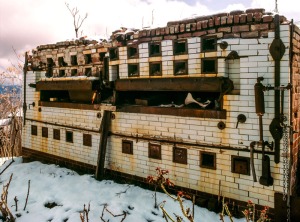
The old bakery ovens are still hanging around in the back yard of one of my friends, (Photo by Bob Swanson)
Before new mine owners forbid walking down to the 500-level, I loved walking around the foundations of the housing units for mid-level employees (plumbers, carpenters, electricians). I loved sneaking into the old mining building known as the “Dry” with its rows of empty lockers and broken-up shower stalls. I could easily visualize 1500 miners simultaneously showering up after their shifts and hanging their clothes to dry on pulleys that hoisted them high into the rafters. Vaporous ghosts.
For old-timers who return by the hundreds for the annual town reunion called “Spook Days,” ruins were the roots of their powerful attachment to Jerome. “I was only here from 1928-1948, but I feel a strong attachment to Jerome. No other place I’ve ever lived in have I felt that attachment,” said one old Mexican.
Another said, “I was only three years old when I left Jerome, but I remember things. . . I remember my father’s house. I remember the snow. And I remember sitting on my grandmother’s balcony at night, looking down into the valley. I could hear crickets and it was so peaceful.”
Ruins revealed oddities about people who used to live here. One of my favorite ruins was the old homestead where Father John used to live. When he died, he left behind a lot of junk: rusting cars, collections of stoves, and a room full of ladies shoes, singles only. Now what would a priest be doing with so many ladies’ shoes? Father John’s home mysteriously burned the night after he was found collapsed and dehydrated in his bedroom at the Catholic Church and was dragged to the hospital. Years later, the homestead was replaced with the new Gold King Mine, which includes a lot of old pre-fifties trucks, a museum of mining relics and old sawmill from Weed, California. There never was a mine there, much less one that mined gold.
A new town has emerged, full of its own colors and legends, a village of little crime and high spirits. The ghost town is all but gone.
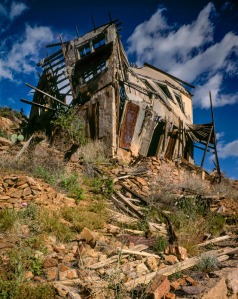
One of my all time favorites ruins, now the cover of Rich Town Poor Town by Roberto Robago, a great book. The ruin was in perfect splay when Bob took the shot. Then it fell down. (Photo by Bob Swanson)
But when the oldtimers die, who will share the memories and secrets of old Jerome? And when the ruins are gone, where will the ghosts hide?
Updated from an earlier blog.

